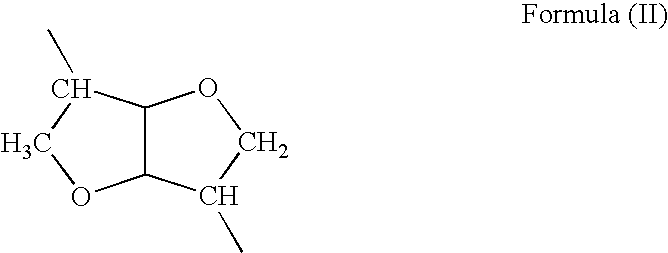Wound healing polymer compositions and methods for use thereof
- Summary
- Abstract
- Description
- Claims
- Application Information
AI Technical Summary
Benefits of technology
Problems solved by technology
Method used
Image
Examples
example 1
[0247] Amide Bond Formation This example illustrates the coupling of a carboxyl group of a polymer with an amino functional group of the bioactive agent, or equally, the coupling of a carboxyl group of the bioactive agent with an amino functional group of a polymer.
[0248] Coupling Through Pre-Formed Active Esters; Carbodiimide Mediated Couplings—Conjugation of 4-Amino-Tempo to Polymer The free carboxylic acid form of the PEA polymer is converted first to its active succinimidyl ester (PEA-OSu) or benzotriazolyl ester (PEA-OBt). This conversion can be achieved by reacting dried PEA-H polymer (i.e. PEA with free pendant carboxylic acids) with N-Hydroxysuccinimide (NHS) or 1-Hydroxybenzotriazole (HOBt) and a suitable coupling agent, such as dicyclohexylcarbodiimide (DCC), in anhydrous CH2Cl2 at room temperature for 16 hrs. After filtering away the precipitated dicyclohexylurea (DCU), the PEA-OSu product may be isolated by precipitation, or used without further purification, in which c...
example 2
[0250] Ester Bond Formation This example illustrates coupling of a carboxyl group of a polymer with a hydroxyl functional group of the bioactive agent, or equally, coupling of a carboxyl group of the bioactive agent with a hydroxyl functional group of a polymer.
[0251] Carbodiimide Mediated Esterification For the conjugation, a sample of the carboxyl-group-containing polymer was dissolved in DCM. To this slightly viscous solution was added a solution of the hydroxyl-containing-drug / biologic and DMAP in DCM. The flask was then placed in an ice bath and cooled to 0° C. Next, a solution of 1,3-diisopropylcarbodiimide (DIPC) in DCM was added, the ice bath removed, and the reaction warmed to room temperature. The conjugation reaction was stirred at room temperature for 16 hours during which time TLC was periodically performed to monitor consumption of the hydroxyl functional group of the bioactive agent. After the allotted time, the reaction mixture was precipitated, and the Polymer-bioa...
example 3
[0252] This Example illustrates the effect of different concentrations of bioactive agents on adhesion and proliferation of epithelial cells (EC) and smooth muscle cells (SMC) on gelatin coated surfaces.
[0253] Human Coronary artery endothelial cells (EC) plated on gelatin coated culture plates were co-cultured with EC special media containing one of the bioactive agents shown in Table 1 below in the various concentrations shown.
TABLE 1Bioagents100 μM10 μM1 μM100 nmABradykinin[Hyp 3]37237.233.720.372BBradykinin322.832.283.2280.3228CAdenosine80.168.0160.8160.0816DSphingosine 1-113.8511.3851.13850.11385Phosphate (S1P)ELysophosphatidic137.5513.7551.3750.1376Acid (LPA)FControlNoadditives
Cells cultured under similar conditions without adding bioagents are considered as ‘Control.’
[0254] Twenty-four hours later the cells were observed microscopically, stained with trypan blue and counted. The results of the microscopic observation of cell morphology and confluency of culturing the EC in...
PUM
| Property | Measurement | Unit |
|---|---|---|
| Time | aaaaa | aaaaa |
| Time | aaaaa | aaaaa |
| Time | aaaaa | aaaaa |
Abstract
Description
Claims
Application Information
 Login to View More
Login to View More - R&D
- Intellectual Property
- Life Sciences
- Materials
- Tech Scout
- Unparalleled Data Quality
- Higher Quality Content
- 60% Fewer Hallucinations
Browse by: Latest US Patents, China's latest patents, Technical Efficacy Thesaurus, Application Domain, Technology Topic, Popular Technical Reports.
© 2025 PatSnap. All rights reserved.Legal|Privacy policy|Modern Slavery Act Transparency Statement|Sitemap|About US| Contact US: help@patsnap.com



